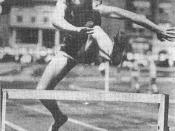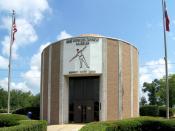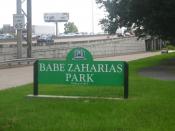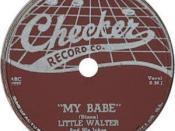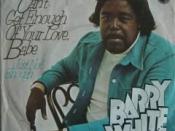Mildred Ella Didriksen Also known as Babe Didrikson Zaharias Birth Date: June 26, 1911 Death Date: September 27, 1956 ADMIRABLE CHARACTER TRAITS Athletic: Babe Didrikson was most well known for her athletics. For example, she was voted "Woman Athlete of the Year" six times by the Associated Press. Also, she was voted the Woman Athlete of the Half Century by the Associated Press. She won All-American honors three times, too. In golf, she was the first American to win the British Amateur in Scotland in 1947. Also, She was the only golfer to win 17 consecutive golf tournaments in the late1940s. She set four world records in track and field during the 1932 Olympics in Los Angeles. The track and field records were set in baseball throw with 272 feet and 2 inches, 80-meter hurdles in 11.7 seconds, javelin with 143 feet and 4 inches, and high jump with 5 feet and 5ü inches.
Leader: Babe Didrikson was born during a time when women athletes had few chances for competitions. Their participation in sports were controversial, and they were looked down upon for being "tomboys". In 1920, the nineteenth amendment was passed, letting women the right to vote and more freedom for women. Babe took this opportunity to its fullest potential. In 1932, she entered as the only representative for Employer's Casualty in the Amateur Athletic Union track and field meet in Illinois. She won first with a score of 30 to move onto the 1932 Olympics. Later, in 1949, along with George Zaharias, Patty Berg, and Fred Corcoran, Babe founded the Ladies Professional Golf Association. All of Babe's athletic achievements and records set the pace for future women athletes, too.
Brave: Babe Didrikson went through numerous operations and surgeries towards the end of her lifetime. Although she was sick, she went out to play golf, whenever she had the strength. Her first major operation was in 1952 when doctors operated on her strangulated hernia. In 1953, she was diagnosed with cancer in her rectum, so she had another operation, a colostomy. She had a successful surgery, but the doctors found more cancer in her lymph nodes. They decided not to operated on it or tell her until she started feeling pain, though. From 1953 until her death, she went in and out of the hospital for x-ray treatments. In 1953, she started feeling pain from the cancer in her lymph nodes, so they operated on her again. In 1955, she was diagnosed with a ruptured disc of the spinal column after she helped her friend push her car out of a sand pit. This caused immense pain, so in 1956 she had another operation. The doctors cut off her nerves in her lower neck to lessen the pain. This was her last operation because she died later that year in the hospital.
OBSTACLES, DIFFICULTIES, AND IMPORTNANT CHOICES Obstacle: Starting in 1952 until Babe's death, her health began to drop, which affected her golf performances. She would get tired and lose her strength before finishing a round or tournament. She was diagnosed with a strangulated hernia in 1952 because all of her physical activities. Doctors operated on her and said that she was cured after the operation. She started to play golf again and was winning first, but then she became ill again. In 1953, she was diagnosed with cancer in her rectum. Doctors gave her a colostomy, and told her that she was cured, even though they found more cancer in her lymph nodes. They did not tell her because she could not feel anything yet. She played golf again until she started to feel the pain. Doctors operated on her lymph nodes in 1953, and again cured her. Babe continually went in and out of the hospital for x-rays to watch for new developments. She played golf whenever she had the strength. Later in 1955, she was diagnosed with a ruptured disc of the spinal column after helping her friends push her car out of a sand pit. Since she felt lots of pain, doctors operated on her one last time. They cut off her nerves in her lower neck to lessen the pain. After her operation, she went downhill and never recovered. She never played golf after her last surgery because she was too tired and weak. Later that year, she died in the hospital at the age of 45.
Difficulty: During the 1932 Olympics, bad luck was on Babe's side three times. During the finals of the running high jump, it was between Jean Shiley, the American team captain, and Babe. They both cleared and set world records at 5 feet and 5 inches and were still tied, so a jump-off was held. They raised the bar to 5 feet and 6 inches. Jean failed to clear the bar, so Babe tried to clear it. She jumped and cleared the bar by 4 inches, but as she landed, she kicked the standard down. The judges ruled it a miss even though it was plain to see that she had cleared the bar. The judges then moved the bar down to 5 feet and 5ü inches. Both Jean and Babe cleared the bar and set the world record even higher, but once again, luck was not on Babe's side. The judges ruled that Babe's style of jumping was not allowed even though she jumped the same style the whole day. The Olympic rule for jumping was the high jumper had to clear the bar feet first. Babe did a "dive" style so her head went first, while Jean did the original "scissors" style so her feet went first. Babe received silver even though she cleared the 5 feet and 5ü inches with Jean. The final disappointment for Babe was that the Olympic rule for "feet first" was eliminated the following year because of controversy.
Important Choice: Babe was part of the Amateur Athletic Union when she played for Employer's Casualty. She was good enough to be a professional, though. During her time, there were not a lot of women professional sports available because the people thought professional sports should be just for men. At first, she wanted to be an amateur because she could compete for medals and break records. Professionals competed but were paid to compete. Later, she decided to become a professional because she needed money. Her parents had always been poor, and they needed some financial support, which Babe gave after becoming a professional. Also, her parents were sick and needed to pay for health care. Babe loved her parents, so when they needed money, she provided. After becoming a professional, she did not become instantly rich, though. She needed to find a professional sport to compete in, so once she founded the Ladies Professional Golf Association and started playing in it, she became a millionaire.
SIGNIFICANT CONTRIBUTIONS TO HUMANKIND Babe founded the Ladies Professional Golf Association in 1949 along with George Zaharias, Patty Berg, and Fred Corcoran. This allowed women to play golf professionally so that they would get paid for competing. There was never a professional sports league for women athletes before the Ladies Professional Golf Association was founded, too. She helped encourage and inspire others to start women's professional sports leagues.
Babe was a born leader. She used her leadership to lead the way for future women athletes. No woman before her time had ever been so bold to encourage women sports both amateur and professional. Even though "tomboys" like her were despised, she pushed that factor aside and spoke up for women athletes. She showed the world with all her awards, achievements, and records that not only men could play sports but also women could.
